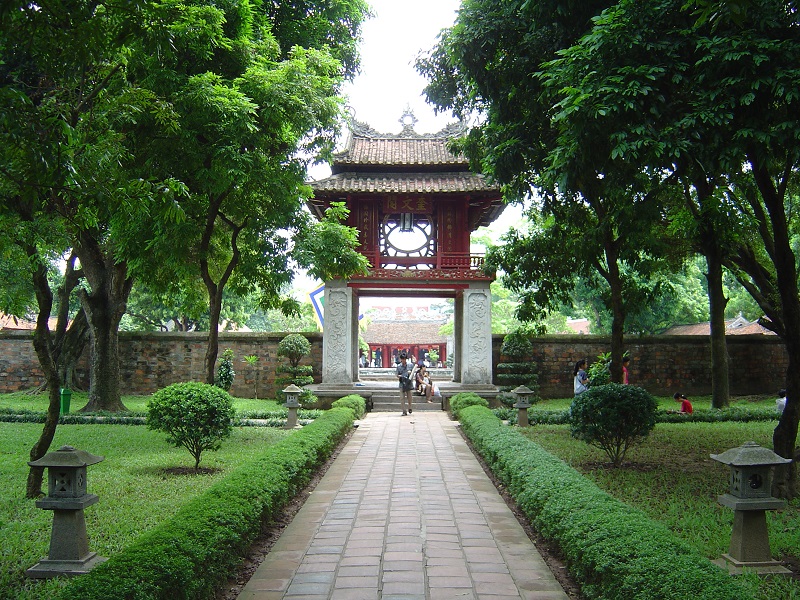
Facts about the Temple of Literature in Hanoi
Have you ever noticed that what an ancient complex used as the symbol of Hanoi as well as printed on one side of the 100,000 VND note? The answer is Temple of Literature – Vietnam’s oldest Imperial Academy under the feudal courts and the first national university.
1.Hanoi’s Temple of Knowledge
The Temple of Literature lies in the west of the old town of Hanoi. Since 948 years, it has been recognized as the oldest university as well as the most important sanctuary in the country. The quiet and pleasant atmosphere of the building with five walled courtyards with extraordinary sights is an oasis of relaxation in Hanoi. A visit to this venerable Temple offers you chances to learn more about the country’s traditional architecture and culture.

2.Education place of the royal sons
In 1070, Ly Thanh Tong, the third emperor of the Ly dynasty, commanded the construction of the Confucian complex – a place of wisdom in respect to Confucius and his docile disciples. The Temple of Literature in Hanoi was the first university in Vietnam and served during 1076 and 1915 to teach the sons of the aristocracy and the mandarin. Afterwards, the temple complex is no longer used for educational purposes. Larger alterations to the Temple of Literature then took place in the Tran dynasty between 1225 and 1400.

3.Unique courtyards of the university

Five walled courtyards surround the entire complex of the literary temple and are connected by gates or pavilions. The central gates in the courtyards could only be occupied by the rulers of the time; the longer ways were intended for servants or other visitors to enter the temple complex.
 The second courtyard features a well-maintained garden as well as the important Pavilion of the Constellation of Literature built in 1802. Besides its functions as meeting place of scholars were held in the past, the two-storey pavilion was also used for readings and speeches.
The second courtyard features a well-maintained garden as well as the important Pavilion of the Constellation of Literature built in 1802. Besides its functions as meeting place of scholars were held in the past, the two-storey pavilion was also used for readings and speeches.
 Famous steles of successful graduates are exhibited in the third courtyard. However, many steles not only include their name and test results but also ornaments with ying-yang symbols.
Famous steles of successful graduates are exhibited in the third courtyard. However, many steles not only include their name and test results but also ornaments with ying-yang symbols.
 The fourth courtyard carries a great spiritual significance, in which it leads through the gate named “Gateway to Great Success”. Today you can see the statue of the great scholars here in the Temple of Literature. The individual stations and the presentation of the stages of the Confucian doctrine characterize the venerable Temple of Literature and make clear the significance of the oldest university in Vietnam.
The fourth courtyard carries a great spiritual significance, in which it leads through the gate named “Gateway to Great Success”. Today you can see the statue of the great scholars here in the Temple of Literature. The individual stations and the presentation of the stages of the Confucian doctrine characterize the venerable Temple of Literature and make clear the significance of the oldest university in Vietnam.
 The fifth courtyard encloses the building of the national university.
The fifth courtyard encloses the building of the national university.
 4.The cultural heritage of Hanoi
4.The cultural heritage of Hanoi

Various wars and attacks in Hanoi in the past caused harms to the Temple of Literature more than once. When the French troops recaptured the city in 1947, the entire complex of the literary temple was severely damaged and has been extensively renovated. Till nowadays, the Temple of Literature itself remains an important historical and cultural building in the urban setting, carrying related cultural values from the glittering past of Hanoi.
5.The Temple of Literature in the modern day
In modern times, the Temple of Literature is a popular must-see sight in the city and welcomes a significant flow of visitors daily. The individual courtyards of the literary temple are modeled on the Confucian doctrine and are complemented by a truly beautiful and well maintained garden. The most important parts in the Temple of Literature are the stone steles, on which the names and the results of successful students were recorded for posterity. The tests in the Temple of Literature were among the hardest of the time and the failure rates were extremely high. Hence, it was a special honor to have successfully passed the exam and to have one’s name carved on the steles, which are worn by stone turtles – the symbol of wisdom.
Source: graylinevietnam




